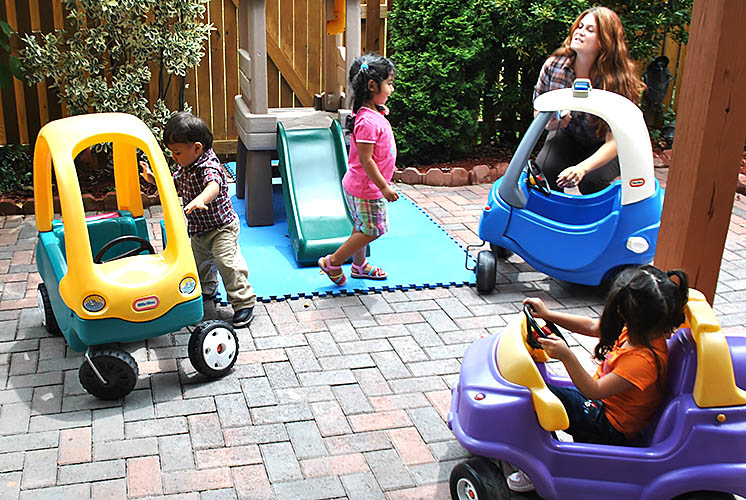 Ideally, each infant and toddler indoor area has direct access to the outdoor play space.1 If there is no direct access, help staff think about ways to transport children. For example, use wagons, buggies, or strollers for non-mobile infants and allow mobile infants and toddlers who can walk short distances to do so. Arrange for additional staff to help the walkers get to the outside space, if needed. If the outdoor play space is too far for mobile infants and toddlers to walk to easily, transport small groups of children using wagons, buggies, or strollers.
Ideally, each infant and toddler indoor area has direct access to the outdoor play space.1 If there is no direct access, help staff think about ways to transport children. For example, use wagons, buggies, or strollers for non-mobile infants and allow mobile infants and toddlers who can walk short distances to do so. Arrange for additional staff to help the walkers get to the outside space, if needed. If the outdoor play space is too far for mobile infants and toddlers to walk to easily, transport small groups of children using wagons, buggies, or strollers.
If one outdoor play space serves both infants and toddlers, create a separate area for infants that keeps them safe from toddlers' more active play. Separate the areas by creating a low barrier; see the Barriers and Pathways section in this Appendix. Within the infant area, make sure there is a protected space for young infants that allows them to look around and move freely; older infants need space for crawling and sturdy objects and rails they can use to pull themselves up to stand. Remember, outdoor play spaces for infants and toddlers need to meet many different developmental levels, including access for children with suspected delays and identified disabilities that affect their ability to move independently and who may rely on adaptive equipment to sit, stand, and move around.
Convenient access to diapering and hand washing is another idea to consider. Yes, routines such as diapering can be done outdoors! If possible, provide a secluded area for diapering and access to water and soap for hand washing; this is always the preferred method for hand hygiene. If there is no running water outdoors, use an alcohol-based hand sanitizer (CFOC 3.2.2.2: Handwashing Procedure). If a sink is available, check with local licensing to make sure it, and the disposal of its wastewater, meets health requirements. If diapering outdoors is not an option and there is no separate bathroom for toileting right off the outdoor play space, maintain appropriate staff-child ratios by providing coverage for staff who need to take children indoors.
Home visitors can talk with families about their access to the outdoors. Start by asking families questions such as:
- How often do they take their children outside?
- Do they have easy access to open play spaces or safe and stimulating playgrounds?
- Do they have wagons, strollers, buggies, or sleds to more easily transport their children or can they walk with older infants and toddlers?
- What do they enjoy most about being outside?
- What is the greatest challenge about going outside?
1Lally et al., Guide to Setting Up Environments, 56; Post et al., Tender Care and Early Learning, 249.
Read more:
Resource Type: Article
National Centers: Early Childhood Development, Teaching and Learning
Last Updated: December 7, 2019
